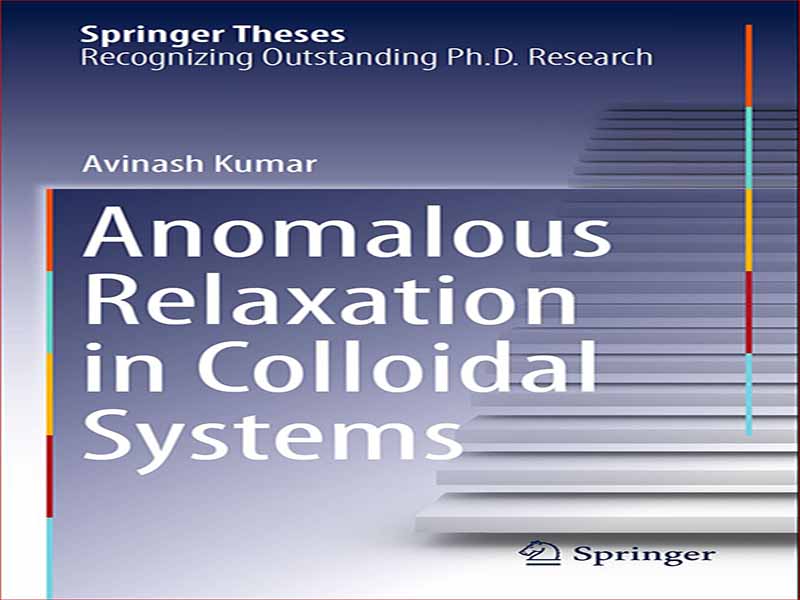- عنوان: Anomalous Relaxation in Colloidal Systems
- نویسنده: Avinash Kumar
- حوزه: نظریه فیزیک، داینامیک
- سال انتشار: 2022
- تعداد صفحه: 135
- زبان اصلی انگلیسی
- نوع فایل: pdf
- حجم فایل: 4.59 مگابایت
هنگامی که یک سیستم آشفته می شود، تمایل دارد که به حالت تعادل بازگردد. سادهترین توصیف نظری آرامش به عنوان تابعی از زمان t پس از اغتشاش، یک قانون نمایی ∝exp(-t/τ) با زمان مشخصه τ است. در واقع، حرکت فروپاشی نوسانگرهای هارمونیک میرا، آرامش حرارتی یک جسم معمولی به دمای محیط آن، و تخلیه یک خازن، همگی آرامش نمایی را نشان میدهند، با نرخهای فروپاشی مستقل از زمانی که سیستمها از حالت تعادل دچار اختلال میشوند. با این حال، در بسیاری از موارد، آرام سازی سیستم ها به دور از نمایی است و ممکن است به تاریخچه آشفتگی آنها بستگی داشته باشد [1]. پویایی سیستمهای بینظم، که از یک حالت آشفته اولیه به سمت تعادل آن شروع میشود، اغلب میتواند آهسته باشد و چندین مکانیسم آرامسازی مختلف را بهطور موازی شامل شود. به عنوان مثال، آرامش لگاریتمی به طور تجربی در تراکم شن و ماسه در یک لوله [2]، پوسیدگی جریان در ابررساناها [3]، شل شدن حجم در کاغذ مچاله [4]، آرامش مکانیکی ریشههای گیاه [5] و استحکام اصطکاکی مشاهده شده است. [6]. در فیزیک حالت جامد، سیستم های شیشه ای دینامیک بسیار آهسته ای را در زیر و درست بالای انتقال شیشه ای نشان می دهند. در انواع سیستمها، در زمانهای کوتاه (کمتر از زمانی که نیروی خارجی وارد شده است)، دینامیک آرامش لگاریتمی است (∝ln(tw/t))، در حالی که یک قانون قدرت (∝tw/t) ) در زمان های طولانی مشاهده می شود [7]. این آرامشها بسیار کندتر از فروپاشی نمایی یا کشیدهای هستند و زمانهای تعادل آنها اغلب از نظر تجربی غیرقابل دسترس است. پروتئینها مشابه عینکها، فرآیند آرامسازی آهستهای را نشان میدهند که به بهترین وجه توسط یک نمایی کشیده شده زمانی که توسط دما و فشار مختل میشوند، توصیف میشود [8]. رفتارهای نمایی کشیده نیز در سیستم هایی مانند شیشه های مولکولی و الکترونیکی [9]، مذاب های تشکیل دهنده شیشه فلزی [10] و سیستم های دانه ای [11] مشاهده می شود. پویایی آرامش که توسط این قوانین کنترل می شود به طور غیرعادی کند است و ممکن است طولانی تر از حد معمول استراحت کند. به طور کلی، هنگامی که چنین سیستمهایی مختل میشوند، آرامش تا تعادل شامل آرامش طیفی از حالتها میشود. هر یک از حالت ها به طور مستقل و به صورت تصاعدی به حالت تعادل خود ریلکس می شوند، اما با نرخ آرامش متفاوت. در برخی موارد، برخی از این حالتها ممکن است در حالتهای ناپایدار به دام افتاده و با زمانهای طولانی تعادل آرام شوند. اگرچه شناخته شده ترین ناهنجاری های آرامش شامل آرامش های بسیار آهسته است، اما کلاس دیگری وجود دارد که در آن آرامش می تواند بسیار سریعتر از حد انتظار باشد. شناخته شده ترین این تحقیقات مربوط به یک اثر خنک کننده غیرعادی در آب است که به عنوان اثر Mpemba شناخته می شود [12]. تحت شرایط خاصی، یک نمونه آب گرم در ابتدا می تواند سریعتر از نمونه آب گرم اولیه منجمد شود. این اثر ممکن است غیرقابل درک به نظر برسد، زیرا شهود ما توسط سیستم هایی تنظیم می شود که در تعادل یا نزدیک به آن باقی می مانند. در این صورت، سیستمی که از دمای بالاتر شروع می شود، نمی تواند بدون عبور از تمام دماهای میانی به تعادل برسد. با این حال، در یک خاموش کردن حرارتی، سیستم ها در تعادل باقی نمی مانند. بنابراین، وضعیت سیستم در هر لحظه با یک دما توصیف نمی شود. یک گرادیان دمایی بزرگ را می توان توسط جریان های همرفتی در حجم تنظیم کرد و ممکن است با یک میدان دمایی T (x, t) نمایش داده شود. می توان میانگین فضایی T (x, t) را با سرد شدن آب محاسبه کرد، اما دمای متوسط نشان دهنده آبی نیست که در ابتدا در همان دما تهیه شده بود. بنابراین، سیستم لزوماً برای رسیدن به تعادل لازم نیست از تمام حالات میانی عبور کند و گاهی اوقات می تواند سریعتر خنک شود. پس از کشف آنها در آب، این اثرات خنک کننده غیرعادی در سایر سیستم های فیزیکی مشاهده شد که نشان می دهد چنین رفتاری ممکن است یک پدیده عمومی در طبیعت باشد.
When a system is perturbed, it tends to relax back to equilibrium. The simplest theoretical description of relaxation as a function of time t after a perturbation is an exponential law ∝exp(−t/τ ) with a characteristic time τ . Indeed, the decaying motion of damped harmonic oscillators, thermal relaxation of a typical body to its ambient temperature, and discharging of a capacitor all exhibit exponential relaxation, with decay rates independent of the time at which the systems are perturbed from equilibrium. However, in many cases, the relaxation of systems is far from exponential and may depend on their history of perturbation [1]. The dynamics of disordered systems, starting from an initial perturbed state towards its equilibrium, can often be slow and involve a number of different relaxation mechanisms in parallel. For example, logarithmic relaxation has been experimentally observed in compaction of sand in a tube [2], the current decay in superconductors [3], volume relaxation in crumpling paper [4], mechanical relaxation of plant roots [5], and frictional strength [6]. In solid-state physics, glassy systems show extremely slow dynamics below and just above the glass transition. In a variety of systems, at short times (less than the time tw during which an external force has been applied), the relaxation dynamics are logarithmic (∝ln(tw/t)), whereas a power-law (∝tw/t) is observed at long times [7]. These relaxations are much slower than exponential or stretched exponential decay, and their equilibration times are often experimentally unreachable. Similar to glasses, proteins display a slow relaxation process best described by a stretched exponential when perturbed by temperature and pressure [8]. Stretched exponential behaviors are also observed in systems such as molecular and electronic glasses [9], metallic glass-forming melts [10], and granular systems [11]. The relaxation dynamics governed by these laws are anomalously slow and can take longer than usual to relax. Generally, when such systems are perturbed, relaxation to equilibrium involves the relaxation of a spectrum of modes. Each of the modes relaxes independently and exponentially to its equilibrium, but with a different relaxation rate. In some cases, some of these modes may get trapped in metastable states and relax with long equilibration times. Although the best-known relaxation anomalies involve very slow relaxations, there is another class where relaxation can be much faster than expected. The best-known of these investigations concerns an anomalous cooling effect in water, known as the Mpemba effect [12]. Under certain conditions, an initially hot sample of water can freeze faster than an initially warm sample of water. The effect may appear counterintuitive, as our intuitions are set by systems that remain at or near equilibrium; in that case, a system starting at a higher temperature cannot reach equilibrium without passing through all the intermediate temperatures. However, in a thermal quench, systems do not remain in equilibrium. Thus, the state of the system at any instant is not described by a single temperature. A large temperature gradient can be set up by convective currents within the volume and may be represented by a temperature field T (x, t). One can calculate the spatial average of T (x, t) as the water cools, but the average temperature does not represent the water that had been initially prepared at the same temperature. Thus, the system does not necessarily have to pass through all the intermediate states to reach equilibrium and can sometimes cool faster. After their discovery in water, these anomalous cooling effects were observed in other physical systems, suggesting that such behavior may be a general phenomenon in nature
این کتاب را میتوانید بصورت رایگان از لینک زیر دانلود نمایید.



































نظرات کاربران